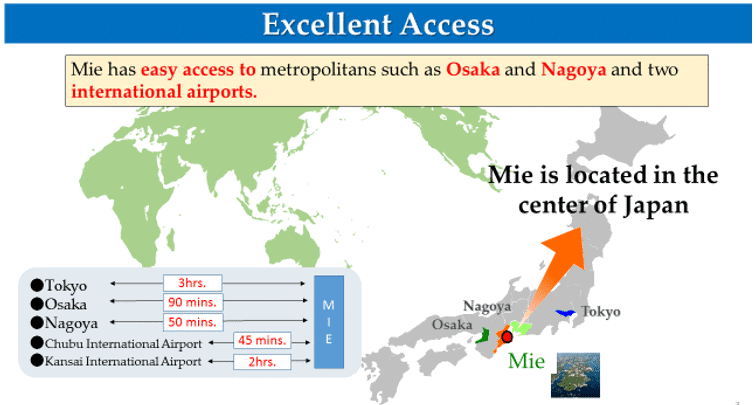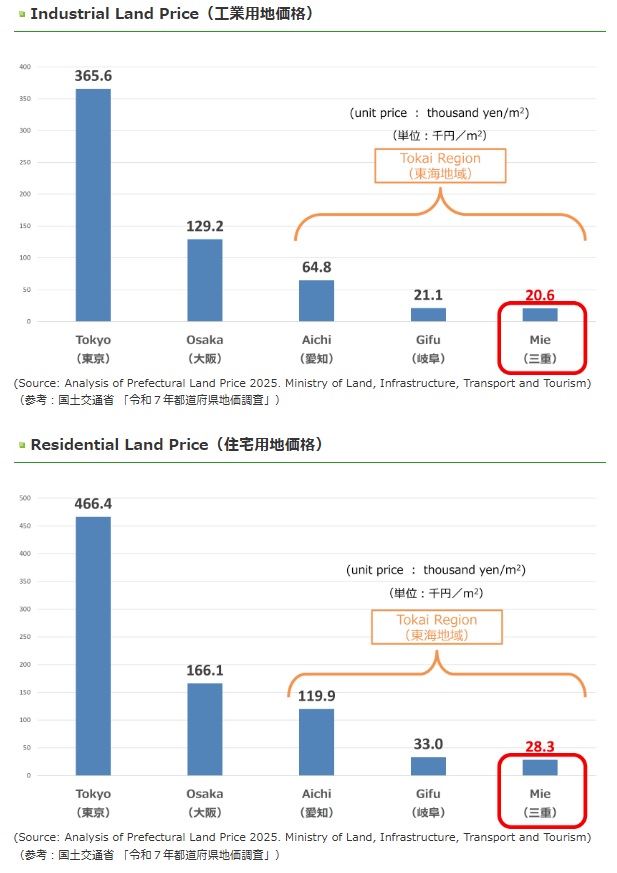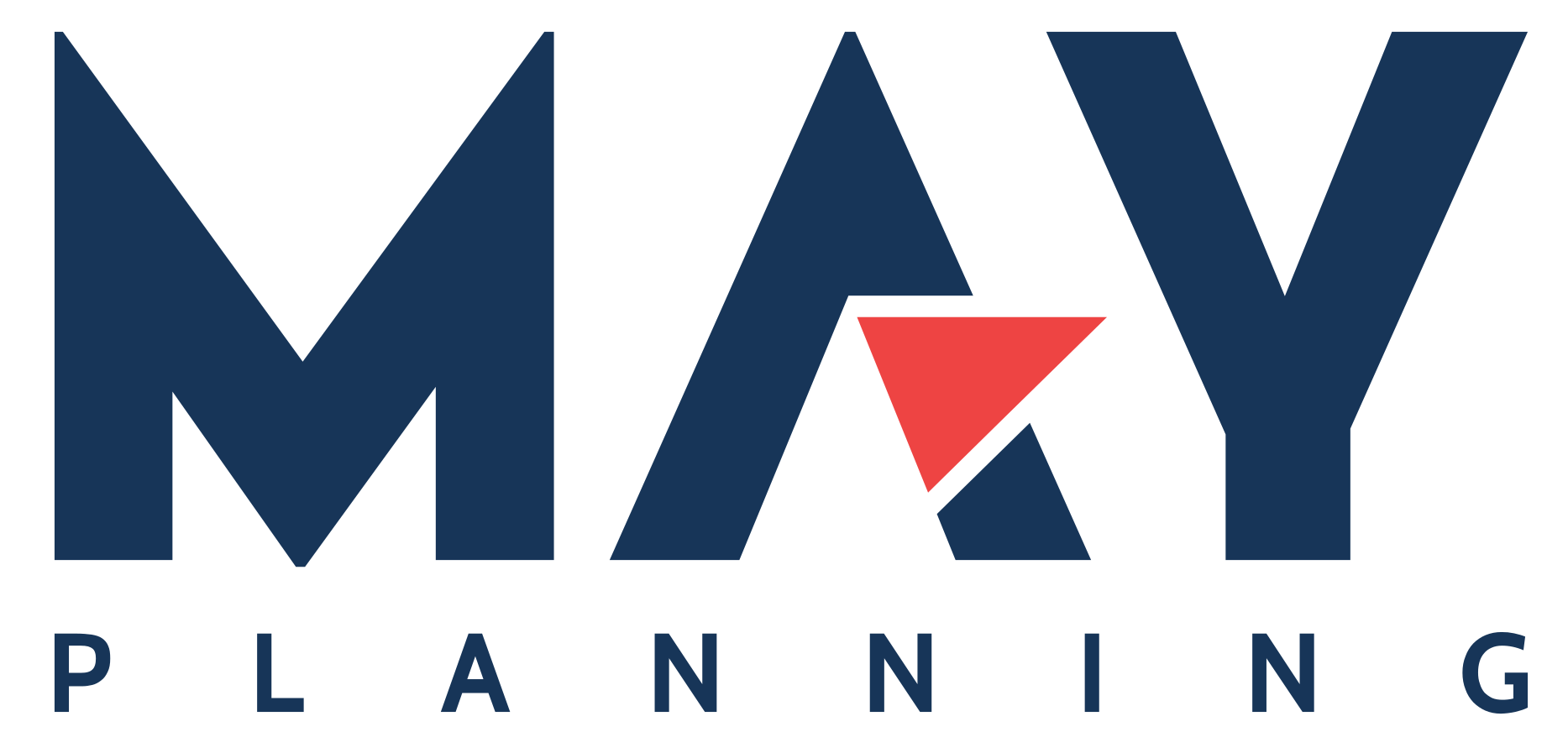Mie Prefecture: Japan’s Hidden Industrial Powerhouse Bridging Kansai and Chubu
When international companies think of Japan’s major industrial zones, Tokyo, Osaka, and Nagoya often come to mind. Yet quietly positioned between the Kansai and Chubu regions, Mie Prefecture has established itself as one of Japan’s most dynamic industrial and logistics centers — a place where global manufacturers, high-tech innovators, and sustainable enterprises operate side by side. With its well-balanced mix of heavy industry, advanced technology, and quality living, Mie offers a compelling case for overseas companies seeking both strategic market access and a stable, cost-efficient operating base.
In this article, we take a closer look at what makes Mie Prefecture a compelling choice for global companies — from its industrial diversity and strategic location to its supportive government policies and sustainable growth vision.
A Strategic Location Connecting Japan’s Two Major Economic Regions

Mie Prefecture’s greatest asset lies in its geography. It stretches along the eastern coast of the Kii Peninsula, linking the Kansai region (Osaka, Kyoto, Kobe) and the Chubu region (Nagoya, Toyota) — two of Japan’s most powerful economic engines. This dual access gives companies in Mie a unique logistical and commercial edge.
From Mie, businesses can easily reach major domestic markets, ports, and airports within just a few hours. The prefecture sits within 100 km of Nagoya, and less than 150 km from Osaka, enabling fast movement of goods and personnel. It is also part of the Greater Nagoya Economic Zone, a leading cluster for automotive, aerospace, and machinery manufacturing.
Moreover, Mie’s Pacific-facing ports — notably Yokkaichi Port, one of Japan’s busiest international trading ports — provide robust maritime links for export and import. The prefecture’s position along National Route 23, the Tomei and Ise Expressways, and the Kisei Main Line further strengthens multimodal access between the Kansai, Chubu, and Tokyo regions.
For global companies looking to establish manufacturing, logistics, or R&D operations, Mie’s location represents a rare combination of market proximity and cost efficiency — offering reach equivalent to major metropolitan hubs, without the congestion or high real estate costs typically associated with them.
A Diverse and Competitive Industrial Structure
While Mie’s population is modest at around 1.7 million, its industrial output ranks among Japan’s top prefectures. Its strength lies in industrial diversity — a balanced blend of chemicals, semiconductors, automotive, food processing, and energy industries that together form a resilient and interconnected economic base.
Advanced Manufacturing and Technology
Mie Prefecture is home to some of Japan’s most sophisticated manufacturing operations. Yokkaichi City, in particular, serves as a global center for semiconductor production, with Kioxia (formerly Toshiba Memory) and Western Digital operating large-scale fabs there. The area’s established infrastructure, skilled workforce, and strong supply chain make it one of the most important semiconductor production hubs in Asia.
Beyond semiconductors, automotive and precision machinery industries thrive in cities like Suzuka and Inabe, supported by proximity to Toyota’s core operations in Aichi Prefecture. Companies in these sectors benefit from shared industrial ecosystems and logistics networks, as well as strong cooperation with local research institutions and technical colleges.
Energy and Petrochemical Industries
Mie also has deep roots in energy and petrochemicals. Yokkaichi Industrial Complex, stretching along Ise Bay, is one of Japan’s most significant heavy industrial zones, housing oil refineries, chemical plants, and material manufacturers. This area supports not only domestic demand but also serves as a critical base for exports across East and Southeast Asia.
Over the past decade, Mie has been steering these traditional sectors toward decarbonization and green transformation, encouraging companies to integrate renewable energy sources and environmentally friendly production methods. The prefecture is also promoting the development of hydrogen and next-generation energy technologies, aiming to position itself as a model for sustainable industrial transition.
Food and Consumer Goods Manufacturing
Another key pillar is the food and consumer goods sector, which benefits from Mie’s abundant natural resources and access to both domestic and international markets. The prefecture is well known for high-quality local produce such as Matsusaka beef, Ise lobster, and green tea, and many companies have built successful export businesses based on regional agricultural brands. The government actively supports value-added food manufacturing and overseas promotion through initiatives like the Mie Export Support Program.
Innovation Ecosystem and Academic Collaboration
Mie’s industrial ecosystem is strengthened by a robust network of universities, research institutes, and innovation centers. At the heart of this system is Mie University, a national university located in Tsu City, with strong programs in engineering, materials science, and environmental studies. The university collaborates closely with local industries through joint research, technology transfer, and talent training programs.
The Mie Prefecture Industrial Research Institute also plays a pivotal role, offering support in areas such as product development, quality control, and digital transformation (DX). By fostering partnerships between SMEs, large corporations, and academic institutions, Mie nurtures an ecosystem conducive to technological advancement and sustainable growth.
Local governments and business organizations further promote innovation through startup support programs, business matching events, and specialized industrial clusters — particularly in advanced materials, automotive technologies, and energy transition solutions.
A Business Environment Designed for Long-Term Stability

Mie Prefecture provides one of the most balanced and sustainable business environments in Japan. While maintaining advanced industrial functions, it also offers cost advantages and operational stability that are increasingly attractive to international investors.
Competitive Operating Costs
Compared with neighboring metropolitan regions like Osaka and Nagoya, Mie’s land and rental costs are significantly lower, while access to major markets remains comparable. This cost-efficiency extends to utilities and labor, allowing companies to maintain high production standards without the financial pressures typical of large urban centers.
The prefecture also offers well-equipped industrial parks with ready-to-use infrastructure, optimized for manufacturing, logistics, and R&D facilities. Many of these parks — including those in Yokkaichi, Suzuka, and Matsusaka — are situated close to expressways and ports, ensuring both convenience and competitiveness.
Stable Workforce and Educational Support
Mie’s workforce combines technical skill with remarkable stability. The prefecture has a high concentration of engineers, production technicians, and research personnel, particularly in the semiconductor and machinery sectors. Educational institutions such as Mie University, Suzuka University of Medical Science, and various technical colleges and vocational schools contribute a steady pipeline of skilled human resources.
Moreover, local governments actively promote career-matching programs and reskilling initiatives to help companies secure and retain qualified employees. International firms have noted that Mie’s employees demonstrate strong manufacturing discipline, long-term employment commitment, and adaptability to global standards — qualities that align with Japanese industrial excellence.
A Quality Living Environment for Global Talent
Beyond industrial strength, Mie offers a comfortable and culturally rich living environment, ideal for attracting and retaining international talent. The prefecture’s mix of urban convenience and natural beauty creates a distinctive lifestyle advantage rarely found in Japan’s larger cities.
Natural and Cultural Harmony
Mie is blessed with a diverse landscape of mountains, forests, and coastline, offering an excellent quality of life and access to outdoor activities. It is also home to some of Japan’s most significant cultural and spiritual sites, such as Ise Jingu (Ise Grand Shrine) — a symbol of Japanese tradition — and the historic town of Kumano, part of the UNESCO World Heritage–listed Kumano Kodo pilgrimage routes.
Cities such as Tsu, Yokkaichi, and Suzuka combine modern infrastructure with a calm, spacious environment, providing ideal conditions for families and expatriate professionals. The overall cost of living is lower than in major metropolitan areas, yet residents enjoy high levels of public safety, healthcare, and education.
Accessibility and Connectivity
Mie’s connectivity further enhances its attractiveness for foreign companies. The Chubu Centrair International Airport in Aichi and the Kansai International Airport in Osaka are both within two hours’ reach, providing convenient access to global destinations. For domestic travel, the prefecture is well served by the Kintetsu Railway and JR lines, linking major cities across the Kansai and Chubu regions. These transportation links make business trips, logistics operations, and regional collaborations remarkably efficient.
Strong Government Support and Investment Incentives
Mie Prefecture offers extensive support measures for foreign and domestic companies seeking to invest, expand, or establish operations. The prefectural government’s Investment Promotion Division acts as a one-stop support center, providing assistance from the initial planning stage to post-establishment operations.
Financial Incentives and Tax Benefits
Foreign-affiliated companies can access various forms of subsidies, grants, and preferential tax treatments, particularly for projects related to manufacturing, R&D, or employment creation. These include:
- Facility investment subsidies, covering part of construction or equipment costs.
- Employment subsidies, supporting companies that hire local workers.
- Tax incentives for designated high-priority industries, such as renewable energy, semiconductors, and advanced materials.
Additionally, municipalities within Mie — such as Yokkaichi, Suzuka, and Matsusaka — offer their own tailored incentive programs, providing flexible combinations of financial aid, land-use support, and administrative consultation.
The prefecture also supports research collaboration and digital transformation (DX) projects, particularly those aligned with sustainability and smart manufacturing goals. Companies engaged in green innovation or circular-economy models can access R&D partnerships, pilot project subsidies, and public–private collaboration opportunities.
Summary
Mie Prefecture stands out as one of Japan’s most balanced and quietly powerful industrial regions. Positioned between two major economic zones, it combines excellent access, competitive operating costs, and a stable industrial ecosystem. From semiconductors and automotive components to renewable energy and food exports, Mie’s industries reflect both technological depth and adaptability to global trends.
For overseas investors, Mie offers a rare blend of logistical advantage, talent availability, and government-backed incentives that enable sustainable and profitable business operations. Its rich natural environment, cultural heritage, and affordable living further enhance its attractiveness for international professionals and families.
In a country where the metropolitan centers often dominate the spotlight, Mie represents an authentic gateway to Japan’s manufacturing and innovation core — a place where global companies can build enduring success while contributing to the next generation of sustainable industry.
Feel free to contact us
MAY Planning provides advice on market entry to Mie Prefecture. We also offer support on government incentive applications, site selection, business matching and partnership development analysis in Mie.
References:
1)Foreign Direct Investment. (n.d.). Mie Prefecture. https://www.pref.mie.lg.jp/common/05/ci400012574.htm


